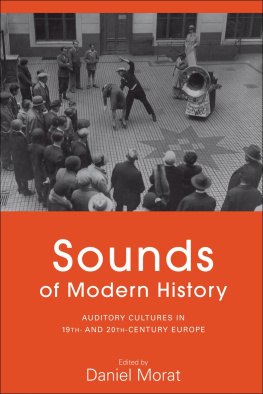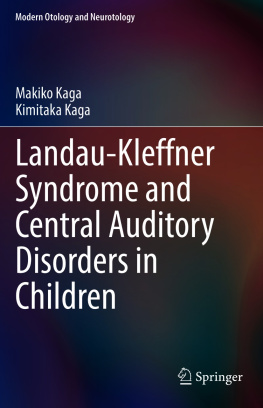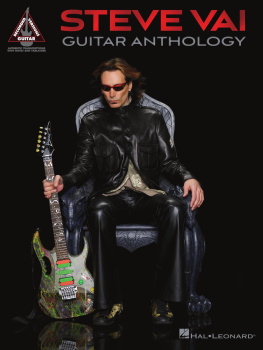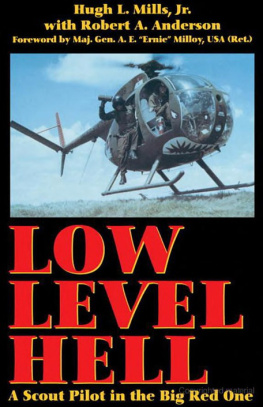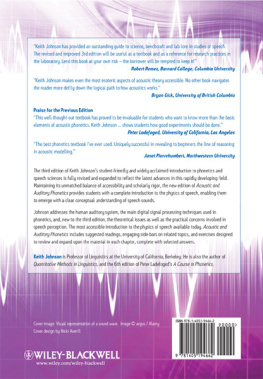First published 2014 by Left Coast Press, Inc.
Published 2016 by Routledge
2 Park Square, Milton Park, Abingdon, Oxon OX14 4RN
711 Third Avenue, New York, NY 10017, USA
Routledge is an imprint of the Taylor & Francis Group, an informa business
Copyright 2014 Taylor & Francis
All rights reserved. No part of this book may be reprinted or reproduced or utilised in any form or by any electronic, mechanical, or other means, now known or hereafter invented, including photocopying and recording, or in any information storage or retrieval system, without permission in writing from the publishers.
Notice:
Product or corporate names may be trademarks or registered trademarks, and are used only for identification and explanation without intent to infringe.
Library of Congress Cataloging-in-Publication Data:
Mills, Steve, 1969
Auditory archaeology : understanding sound and hearing in the past / Steve Mills.
pages cm
Includes bibliographical references and index.
ISBN 978-1-61132-079-4 (hardback : alk. paper)
ISBN 978-1-61132-081-7 (institutional ebook)
ISBN 978-1-61132-713-7 (consumer ebook)
1. ArchaeologyMethodology. 2. HearingSocial aspectsHistory.
3. SoundsSocial aspectsHistory. 4. SoundsPsychological aspectsHistory.
5. A rchaeologySocial aspects. 6. Senses and sensation. I. Title.
CC 75.7.M55 2014
930.1072dc23
2014002281
ISBN 978-1-61132-079-4 hardback
Cover design by Jane Burton
In the hills surrounding prehistoric Sesklo in Greece, and in the river valley next to it, there is a glorious interplay of light, rocks, vegetation, water, animals, people, sounds and the weather that makes its setting captivating. I went there in the summer of 1997 as a postgraduate student interested in how people in the past may have understood and engaged with their surroundings. Using the knowledge and skills I had at the time my attempt to convey this dynamic interplay was passable but could have been better. During the time spent at Sesklo I became particularly intrigued by the different ways everyday sounds reveal much about relationships between people, animals and their surroundings. At the time I was not equipped to pursue this further but the possibility of studying it has motivated much of my thinking since then.
After the study visit to Sesklo I started to explore options to investigate some of the ways the senses interweave with and are integral to engagements with archaeological and heritage contexts. I quickly realised that I was not sufficiently informed to adequately consider all the senses. With an existing, reasonable knowledgebase concerning sound, hearing and acoustics I might, however, be able to contribute by considering ways that sound and hearing may have mattered to people in the past.
The first part of this book introduces a wide range of research from across many disciplines concerning sound and hearing in particular and the senses more generally. In becoming more familiar with this body of research I am starting to realise its wealth and far-reaching implications. I have tried to summarise some of it and draw upon aspects of it where appropriate but there is a lot to consider. Regrettably, it is necessary to be selective and there are almost certainly important contributions that I have either overlooked or not had the scope to include here.
The first chapter introduces auditory archaeology and relates it to broader themes in archaeology concerned with the senses and senses of place. asserts the important role that the senses play in everyday life and the culturally and historically specific ways that sound and hearing mediate relationships between people, and between people and their surroundings.
introduces research that considers sound in (pre)historic contexts including studies of ancient sound-producing devices and archaeoacoustics. Important within this body of research is the initiative to explore ways of examining evidence to identify intentionality with respect to the use of sound in the past. It is also evident that, because of the nature of available evidence, the research emphasis is often on the sounds associated with special places and that there has been a limited concern with the range of sounds associated with the everyday tasks performed and places inhabited by people in the past.
To broaden this research, outlines the principles of an auditory archaeology. Auditory archaeology considers the potential contribution of everyday, mundane and unintentional sounds in the past and how these may have been significant to people. It draws on concepts developed in perception psychology and soundscape and landscape studies of various kinds and provides a flexible and widely applicable set of elements related to sound and hearing that can be adopted and adapted for use in a broad range of archaeological and heritage contexts.
I have been fortunate to have opportunities to apply auditory archaeology at locations that are diverse in their spatial, temporal and material characteristics. I studied relationships between human activity areas, topography, river systems and sound in the Teleorman River Valley, Romania, between 1998 and 2001 with the support of colleagues and team members of the Southern Romania Archaeological Project. I explored auditory entanglement at atalhyk, Turkey, in 2004, 2005 and 2007 and worked with colleagues analysing multimedia data from the site in San Francisco in 2006 and 2008. Discussing, studying and mapping landscape character with team members of the Cornish Mining World Heritage Site Bid stimulated a project to investigate auditory attributes of a mining landscape in Cornwall, United Kingdom, in 2005. The outputs of these research opportunities form the case studies in the second part of this book.
It is not easy to write about sound and the auditory experiences of people in the places where sounds are heard: they do not lend themselves readily to inscription. Sound is short lived, ephemeral and dynamic and to convey any of these aspects requires media and approaches that are fluid, permeable and malleable. This can be achieved, in part, through text with the use of, for example, appropriate verbs and onomatopoeia. One of the best examples I have found is John Muirs wonderful account of his experience of climbing a Douglas fir during a storm in the Sierra Nevada, California, in December 1874. The following is an excerpt:
The sounds of the storm corresponded gloriously with this wild exuberance of light and motion. The profound bass of the naked branches and boles booming like waterfalls; the quick, tense vibrations of the pine-needles, now rising to a shrill, whistling hiss, now falling to a silky murmur; the rustling of laurel groves in the dells, and the metallic click of leaf on leafall this heard in easy analysis when the attention was calmly bent.
(Reprinted in Stetson 1994: 113)
It would be marvellous if we were able to evoke the lives and experiences of people in the past as vividly as this. Opportunities to do so though are rare in archaeology because of the evidence we engage with and because our freedom to experiment with literary creativity is usually restricted in the pursuit of and to maintain academic credibility and integrity. In the case studies I attempt to show ways in which sound and hearing may have been significant to people in the past. My ability to do so is determined, in part, by the evidence available but more by my limitations as a wordsmith and as an archaeologist.




